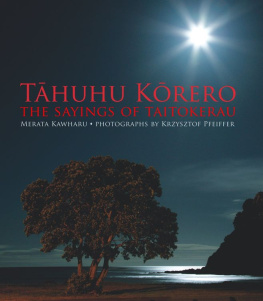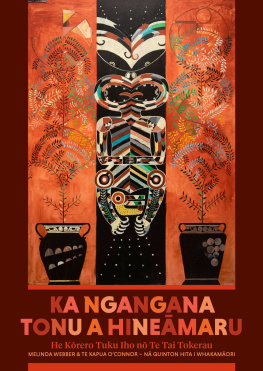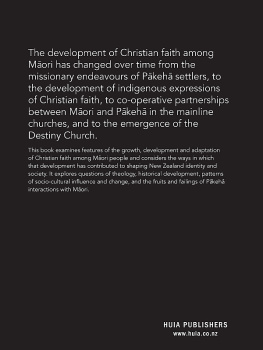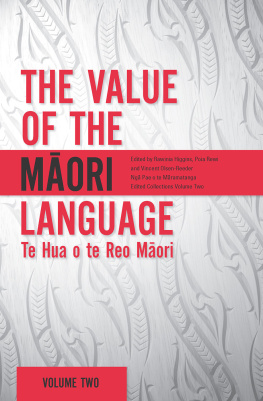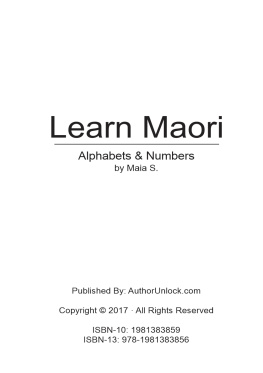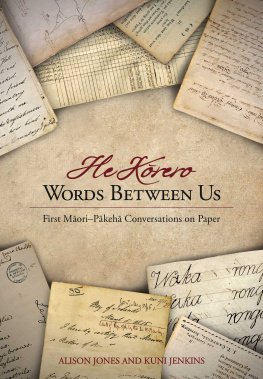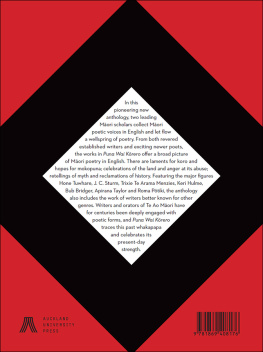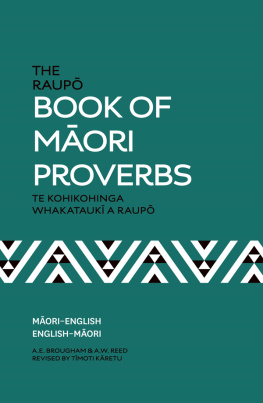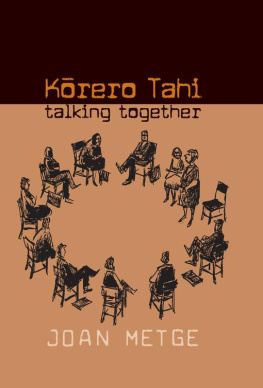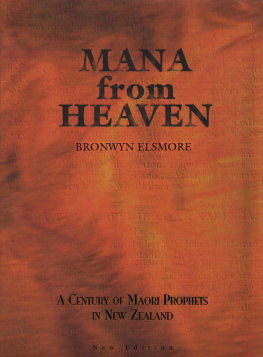Kupu Whakataki
Introduction
JENIFER CURNOW, NGAPARE HOPA AND JANE McRAE
HE MIHI
E te whi ngaro, e te wehi, e te mataku, nei r te mihi, te tangi hoki m koutou mai noa atu, i whakarerea mai nei nei pounamu. I te w i puta nei taonga e tauhou tonu ana ng mahi tuhituhi ngari oti mai ana i a koutou te whakatakoto mai, ar e takoto nei. Koir te whakamharo. N reira e mtou rahi, moe mai me te mhio kua nanao atu mtou, tnei ao, hei whakaako m mtou, hei korowai hoki m mtou pakihiwi. N koutou i whakaara, ko mtou kua waimarie.
Ki te hunga pnui
M koutou hei titiro mai koinei nei kohikohinga whakaaro i puta i ttou tpuna, e whakairo mai nei i rtou whakaaro, te huarahi titiro ki t rtou ao, me ng take huhua katoa i kitea, i whakawhitia he krero, i whakanuitia, ahatia atu e rtou. Ko ttou kua waimarie i nei taonga i mahue mai kia manaakihia, kia pnuihia, kia whakaarohia hoki hei manu m ttou ka rere ki tnei rkau, ki tr, ka tirohia tn peka, me tn rau. M koutou hei piki nei peka, ka whwh i ng pua o tnei rkau kua tupu mai nei, tnei whakaruruhu o te kupu krero.
This book provides an unusual and broad sampling of writing from the nineteenth-century Maori-language newspapers. For Maori readers these examples of the language of the time and the writing and thinking of their ancestors will be especially interesting. For teachers and students of Maori there is variety in writing style, vocabulary and dialect, and the English will be an aid to learning and guide to translation practice. For readers of English the translations offer vignettes of New Zealand history, a predominantly Maori viewpoint, and a sense of the Maori language and writing style. We hope the book will encourage reading of the newspapers themselves, which are easily accessible on the Internet (http://www.nzdl.org/niupepa). Some of the newspapers were published with English translations of some content and the website has English summaries of the entire contents of many titles.
We had two aims in mind when producing this book. The first was to be of use to teachers and students of Maori language and the second was to enable readers of English to enjoy writing by Maori and of the period. We therefore sought diverse items and newspapers. We chose to arrange the sections after the style of the newspapers themselves, many of which followed a regular layout: introductory statements about or greetings to a new newspaper, then editorials, followed by letters, articles, news, obituaries, and an assortment of advertisements. Within the sections we placed items chronologically.
In selecting items for transcription and translation we tried to include something from all the major newspapers those published by government, churches, Pakeha philanthropists and Maori. And we sought variety in the kind and style of texts and writers. Most of the writers are Maori the famous and ordinary but some are Pakeha, who frequently acted as editors. Our criteria for selection also included fine writing, appealing reading, noteworthy language usage (for example, the new vocabulary and phraseology of the nineteenth century and for the press, dialect and poetic expression) and simple and complex language.
In transcribing the Maori language from the newspapers we made some editorial changes. We corrected small or obvious errors of spelling, grammar, word usage and printing, edited out obscure passages and, in longer pieces, sections of less interest. We marked the long vowels in all words and in proper names (as far as these are known), and altered word breaks, capitalisation, and punctuation to conform to contemporary orthography. In some cases we retained variant spellings of words (such as Hnuere/Hnueri or npepa/nuipepa) and unusual expressions, as these are interesting features of the language of the press. We translated a name which had been transliterated to Maori only when it was clear as to whom it referred, such as Te Ptara for the Reverend Buddle.
In translating to English we endeavoured to stay as close as possible to the Maori, yet to retain readability. We considered that the translations would be useful to language learners and so tried, as far as was sensible, to show the correspondence between the Maori and English. Moreover, we wanted the tone and style of the writing to come across, even if this meant a slight strangeness to todays readers. The nineteenth-century language, vocabulary and idioms which distinguish writing for the press are therefore also notable in the English. We chose italics to distinguish the Maori words in the translations and other English text in the book.
The newspapers have the character of their times. In order to leave the texts as close as possible to the way they appeared in the newspapers, we decided not to annotate the translations. We tried to select items which were more or less explicit, although an understanding of some figurative language and of nineteenth-century New Zealand history is at times assumed. For the language learners we expected that the book would be read and studied under the guidance of teachers.
This book arose as part of a research project on the Maori-language newspapers which we carried out at the Department of Maori Studies at the University of Auckland with a grant from the Royal Society of New Zealand Marsden Fund. Our first publication from the project was the collection of articles Rere atu, taku manu! Discovering History, Language and Politics in the Maori-language Newspapers (Auckland University Press, 2002). For the translations in this book we again worked as a team but, although each of us followed the same principles and orthographic conventions, each translation inevitably and properly has the voice of its translator. The variety of items to be translated meant that the team approach was helpful as, for instance, one person by their speciality could illuminate a dialect usage, another a transliteration, another a Biblical reference and so on. We had the benefit too of expertise in the language from Hineira Woodard, Ngahuia Dixon and Koro Evans. We strove for accuracy and finesse but, as is well known in this field, translation is never finished and another reading of ones own or anothers work often leads to some alteration or improvement. We hope, however, that readers of the Maori and the English will enjoy this unusual opportunity to revisit the daily news of the nineteenth-century lives of Maori and Pakeha.
KUPU WHAKAMUTUNGA
I a ttou ka kimi, ka whakaemi, whakakorikori an i t ttou reo rangatira, i ttou tikanga o mua r an ko mtou whakaaro kia pnuitia tnei pukapuka i te wairua i kohikohia ai. Tiakina, arohaina nei kohinga krero kia whai hua ai te take i whakatakotohia ia, kia pupuritia ia, hei huarahi whakamua hoki nei mahi whnui a nunui, a roroa m.
Kia ora.



